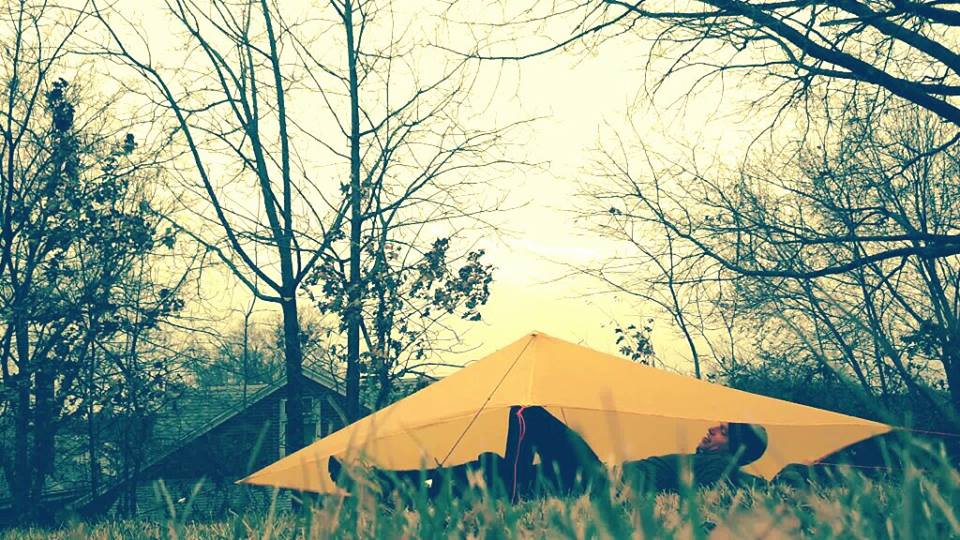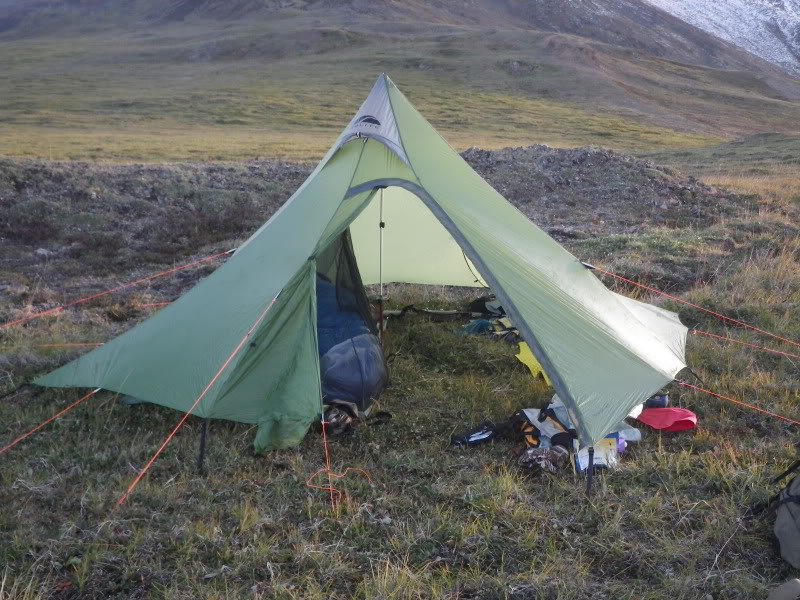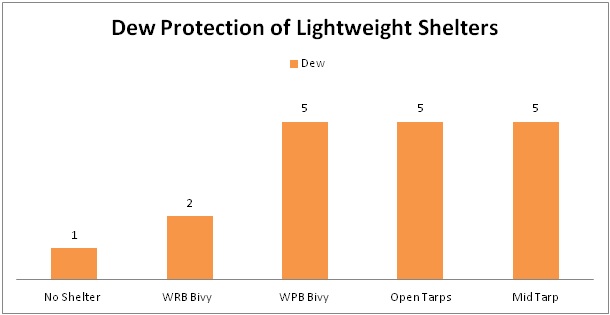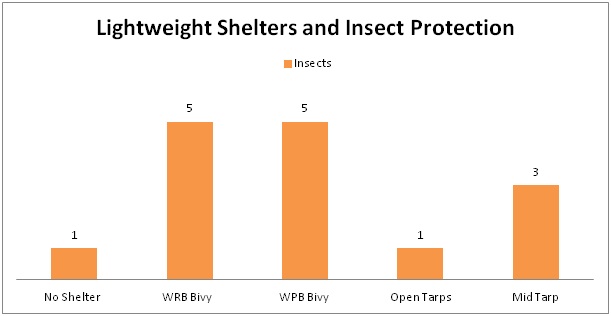In this discussion of lightweight shelters we will be looking at 5 basic shelter options for use in back country travel and discuss some of the advantages and drawbacks of each system in terms of protection they provide.
The scope of the shelter systems we will inspect are:
No Shelter, Water Resistant Breathable Bivy, Waterproof Breathable Bivy, Open Tarp, and the Mid Tarp.
With each option we will be discussing the attributes of each shelter system in terms of its protection from dew, wind, rain, snow, and insects.
Brief Introduction to the Shelter Systems
The following are brief introductions to the shelter systems discussed:
Water Resistant Breathable and Waterproof Breathable Bivy Sacks

Open Tarps
Open Tarps are simple shelters commonly rigged with hiking poles, tent pegs, and guy lines. They come in many designs, from simple rectangle pieces of nylon or plastic to more elaborate shaped cuts made with extremely lightweight and durable fabrics such as cuben fiber. They typically are floorless, though ground sheets are commonly used to keep occupants off bare ground.
Mid Tarps
Mid tarps are similar to open tarps in the way they are rigged, however their design creates a full enclosure with a small gap at the bottom for ventilation.
Dew
Unless you break camp early enough to escape, morning dew is going to fall upon your shelter system.
The following chart provides a breakdown of protection that each shelter system provides against dew in a five point rating system.
No Shelter- Without any protection, dew may be strong enough to soak a sleeping bag which can cause it to lose its loft and warmth. If there is no time to dry it out the accumulative effects over a couple days may wreck havoc to a sleeping system. If dew is a concern a synthetic bag during good weather may be a better suited option when traveling without a shelter.
Water Resistant Breathable Bivy- Because the fabric is not fully waterproof heavy dew is still likely to soak through the permeable fabric, yet it provides more protection than having nothing.
WPB Bivy, Open Tarps, Mid Tarp- The remaining shelter systems offer full protection from dew.
Inclement Conditions
During inclement conditions it is important to be prepared with adequate shelter. The three conditions we will be discussing are wind, rain, and snow.
The following chart shows a breakdown of the protection that each shelter system provides against these conditions in a five point rating system.
No Shelter– Having no shelter provides little protection from inclement conditions. However, the study of wilderness survival skills can help mitigate risk and provide shelter as adequate as the skills, tools, time, and materials that are available to an individual or group.
Water Resistant Breathable Bivy– Provides slightly more protection than no shelter. It is a popular option to combine a WRB Bivy with an open tarp to create a more adequate shelter system.
Waterpoof Breathable Bivy– Although WRB Bivy provides better protection from wind and rain, during a snow storm they are subjected to snow loading. Snow loading is the accumulation of snow on a shelter which can affect the integrity of the shelter. With both WRB and WPB bivy sacks the snow accumulation can compresses the insulation in a sleeping bag which will result in a loss of warmth.
Open Tarps- When analyzing the adequacy of open tarps in inclement conditions it is important to note that protection depends on how and where the tarp is pitched. Understanding campsite selection techniques may increase the ability of an open tarp to provide protection in these conditions. Remember in most situations open tarps will usually have at least one or more open faces to the wind. Open tarps are also subject to snow loading because the structure lacks support. Snow loading can warp the tarps structure and possibly lead to seam failure.

Mid Tarps- Mid tarps provide the most protection in inclement conditions. This is attributed to its design which creates a full perimeter shelter that has no open sides which gives great protection from wind and rain. Mid tarps also handle snow well because it doesn’t accumulate and instead rolls off the tarps steep sides and accumulates around the perimeter.
Insect Protection
Those who have protection from bugs remain sane.
The following chart shows a breakdown of the protection that each shelter system provides against insects in a five point rating system.
No Shelter– Very little protection from bugs without a shelter. However, during cold seasons bugs may not be an issue.
WRB Bivy and WPB Bivy– As long as the bivy is closed it provides excellent insect protection.
Open Tarps- Open tarps by themselves offer very little insect protection. However, open tarps can have no-see-um mesh sewn around the perimeter that can provide adequate protection from bugs. The mesh can also bring small gains in rain protection as droplets accumulate in the lining.
Mid Tarps– Although the bottom of a Mid tarp remains open allowing crawlers open access, the mid tarp provides better protection from flying bugs because the tarp has no open sides. Additionally, flying bugs may seek warmth which gathers towards the top of the tarp, remaining out of the area of the occupant. Mid tarps can also be paired with no-see-um mesh which will increase its bug protection.
Conclusion
Many of the shelters discussed can be less than one pound and smaller than a large water bottle.
But what shelter provides the most protection? It may depend.
Displayed in the chart below are the averages from each of the ratings that each shelter was given from above.

WRB Bivy– Provides more protection in inclement conditions than not having a shelter and provides excellent protection against bugs. A popular option is to pair a WRB bivy with an open tarp to create more adequate protection from dew, wind, and rain.
WPB Bivy– Provides greater protection against dew, wind, and rain than a WRB Bivy but may carry additional drawbacks. Waterproof breathable fabrics such as Gore-tex have come a long way but still lack adequate protection against condensation. You may be dry from the rain, but inside the bivy you may find that condensation and sweat can build up and dampen your bag internally and lead to uncomfortable sleeping conditions. Additionally, bivys provide little in respect to livability.
Open Tarps– Open tarps create the most debate about its adequacy of protection. When dealing with open tarps outdoor experience plays a major role in how the shelter will serve. Open tarps allow flexibility in the ways it can be pitched to accommodate different scenarios. With the addition of mesh lining around the perimeter, the tarp can supply adequate bug protection. When combined with a WRB bivy its protection can be strengthened against wind, rain, and bugs.
Mid Tarp– Receiving the best overall rating, mid tarps provide a wide variety of benefits when compared to other light weight shelter options. It has great performance against dew, wind, rain, and bugs. When encountering snow it is the only shelter analyzed that doesn’t succumb to snow loading due to a steep wall design. Mid tarps are a common shelter system used by a wide variety of the world’s most influential lightweight backpackers.








